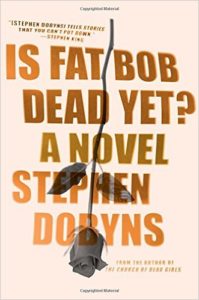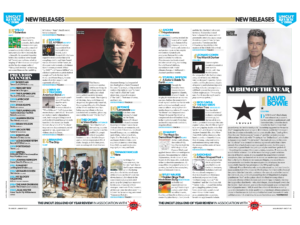„Das weitaus größere Versagen jedoch ist, zu lange nur auf das Spektakel zu starren, das sich gerade abspielt, und an die Vernunft zu glauben, die alles schon richten wird. Die Angst derer zu teilen, die jetzt schon den Hass spüren, den Trump für sich instrumentalisiert hat – Einwanderer, Muslime, Schwarze … Menschen in Aleppo – ist alles andere als irrational. Wann immer spätere Autokraten an der Macht einen Staat zum Instrument der Einschüchterung, Unterdrückung und Gleichschaltung umgebaut haben, hat es oft ähnlich ruhig begonnen wie jetzt. Und zu viele wollten nicht hinsehen. Es gibt also mehr Anlass dafür, wachsam zu sein und jeden Angriff, jede Gefahr klar zu benennen, als sich allzu schnell in einer beschönigten Realität einzurichten.“
(Carsten Juncker, Die Zeit)
Archives: November 2016
2016 30 Nov.
Es wird alles gut werden? Wie bitte?
Manafonistas | Filed under: Blog | RSS 2.0 | TB | 7 Comments
Der Untertitel verspricht viel. Wenn man die Liste der mitwirkenden Stars, Sterne und Sternchen sieht, verstärkt sich der Eindruck noch. Und spätestens der Trailer macht neugierig. Soundbreaking besteht aus acht jeweils 55-minütigen Folgen:
- The Art of Recording. Hier geht es um die alte Frage: Was macht eigentlich ein Musikproduzent?
- Painting with Sound. Die Möglichkeiten früherer und heutiger Tonstudios, bis hin zu dem Punkt, da das Studio selbst zum Instrument wird.
- The Human Instrument. Unerschöpflich: Die Gesangsstimme.
- Going Electric. Die Entwicklung der Musikelektronik, von der elektrischen Gitarre über Effektgeräte bis zum modernen Synthesizer. Die Folge erweckt den Eindruck, die wahren Pioniere seien Beaver & Krause, The Who, Tonto’s Expanding Head Band und Stevie Wonder gewesen. Namen wie Klaus Schulze, Kraftwerk, Tangerine Dream werden nicht mal im Vorbeigehen erwähnt; wenigstens darf Giorgio Moroder kurz ein paar Worte über „Love To Love You Baby“ verlieren, auch Hans Zimmer taucht kurz auf. In einer Folge mit solcher Themenstellung Benny Goodman oder Muddy Waters unterzubringen ist ein Kunststück für sich.
- Four on the Floor. Hier geht es um den Beat, ganz klar. Sehr viel James Brown, Little Richard, Madonna und Bee Gees. Und nochmal Giorgio Moroder mit Donna Summer, bis die Folge dann schließlich bei EDM ankommt, vertreten hier durch Moby.
- The World is Yours. Das Thema ist Sampling, als Technologie wie als Stil. Hier allerdings wird Sampling in erster Linie als die Geburtsstunde des Hip-Hop gesehen und so gut wie ausschließlich durch diese Brille betrachtet. Kraftwerk wird kurz erwähnt („Trans Europa Express“), aber lediglich als Trigger für Afrika Bambaataas „Planet Rock“ dargestellt. (Dass dessen Stück nicht mal gesampelt, sondern eine simple Coverversion ist, fällt den Autoren nicht auf.)
- Sound and Vision. Der Start von MTV und die Entwicklung des Musikvideos.
- I Am My Music. Hier geht es um alte und neue Hörgewohnheiten und Formen der Musikpräsentation, von der Single bis zum Langformat-Konzeptalbum (dessen Erfindung hier seltsamerweise Frank Sinatra zugeschrieben wird (In The Wee Small Hours von 1955, einer seiner größten Flops und eines der wenigen Sinatra-Alben, die ich mag)).
Soundbreaking ist eine Produktion des (weitgehend spendenfinanzierten) Public Broadcasting System. Das heißt: Die Filme haben das typische „Flavour“, das aus irgendwelchen Gründen allen PBS-Dokumentationen eigen ist. Weil man dort immer davon ausgeht, dass das zahlende Publikum ausschließlich an den USA interessiert ist, sind alle Folgen fast vollständig US-zentriert — in diesem Fall mit ein paar kleinen Abstechern nach England, die vor allem wohl George Martin zu verdanken sind, der Co-Produzent der Serie war.
Die Folgen halten sich konsequent an die derzeitige Dokumentarfilm-Mode, auf jeden erklärenden Off-Kommentar zu verzichten und ausschließlich sehr dynamisch geschnittene (und bebilderte) O-Töne aneinanderzuhängen und mit Musik zu unterlegen. Das kann man so machen, es setzt aber voraus, dass man vorher genauestens überlegt, was der Film rüberbringen soll, um dann entsprechend erklärende Schnipsel als O-Ton zusammenzutragen. Hier jedoch sind die Filmemacher offenbar mit der Idee losgezogen, erst einmal so viele Statements wie möglich einzufangen, um dann auszuwählen, welche verwendet werden können. Die Folgen beginnen in der Regel bei ihrem jeweiligen Thema, fasern aber alsbald in ein nichtendenwollendes und sich vom ursprünglichen Thema immer weiter entfernendes Geschwalle aus. Tatsächlich kompetente Gesprächspartner sind ohnehin eher selten, und selbst deren Beiträge sind meist so gekappt, dass kaum Substanzielles übrigbleibt — wohl, weil man fürchtet, mehr als zwei zusammenhängende Sätze würden das Tempo rausnehmen oder die Zuschauer intellektuell überfordern. Wirklichen Hintergrund gibt es folglich so gut wie gar nicht. Statt dessen erleben wir in jeder Folge mindestens dreimal das Statement, Künstler X, Y oder Z habe die Welt der Musik „für immer“ verändert — wodurch aber, das bleibt stets das Geheimnis der Filmemacher.
Das alles schließt nicht aus, dass jede Folge ein paar interessante Aussagen und Musikschnipsel hat, die das Zuschauen letztlich doch wert sind. Irgendwelche fundamentalen Neuigkeiten hat mir die Serie aber nicht vermittelt.
Soundbreaking gibt es im US-Netflix, vielleicht ja auch bald in Deutschland. Ansonsten kann man die DVDs vielleicht bald gebraucht kaufen oder sie in der Bibliothek ausleihen. Viel Geld ausgeben jedenfalls würde ich dafür nicht.
Heute war ich aufgrund des unglaublich klaren Winterwetters auf Fototour durch’s Niederrheinische. Hier zwei Aufnahmen aus Homberg. Die dicken weißen Schlotwolken habe ich nicht aufgenommen, sie ließen mich aber den Song „A Whiter Shade of Pale“ herbeierinnern:
If music be the food of love
Then laughter is its queen
And likewise if behind is in front
Then dirt in truth is clean …
Simple but good. They all play in time and they swing, da braucht keinem Jazztrainer das Blech wegzufliegen. If anyone – Manafonista or a dear reader – likes to present his song of the day here as well, just sent a link in the commentary, maybe with a short note. But it has to be true, from the bottom of the soul. Dann darf auch Grönemeier hier erscheinen oder Dieter Bohlen … – okay, der jetzt nicht. –JS
2016 29 Nov.
„Mr. Sociological Memory Man“ – Mark, Ian and Michael in Manchester
Michael Engelbrecht | Filed under: Blog | RSS 2.0 | TB | Comments off
„All you folks and fools / Cary Grant’s Wedding / All you folks and fools / Have been invited to / A new-wave personality / Stumbles out of the ruins / ‚cause he’s been invited to Cary Grant’s wedding / Buster Keaton he turned up / He wasn’t a woman / He didn’t take hallucigens“
(The Fall)
I’ve always respected the howling of Mark E. Smith, but never had a knack for it. I only had one Fall record in my collection, „Live In Preston“, and it was a birthday gift from my old buddy David Webster who grew up in that fuckin‘ town, north of nowhere, as he put it into words. Weeks ago I had an appontment with another old chap, our master of dark Glasgewian humour, Ian McCartney, in Manchester. He met some old aquaintances, I saw Sebastian Schweinsteiger in a cafe. Well, nothin‘ I would give a dime for. But then, it’s always fun to meet Ian.
We went for some some fantastic Indian food and then to see John Carpenter live. It was a bit nostalgic, the old synthesizer vibes that made us shiver when we were lost in his Halloween and Fog movies. But this time it sounded like pastiche. Kind of. When I was 23 I was ready to fall into love with Jamie Lee Curtis.
Nevertheless John Carpenter once was married to the beautiful DJ at the lighttower of his horror movie „The Fog“, and she really became the role model of Mireia Moreorless, main figure of our review and story about Brian Eno’s „The Ship“. I had another name for her in mind , but Ian’s creation was a stunner. So, to be honest, in that movie I was ready be infatuated with two women at the same time.
For Ian the show had been pretty un-memorable, too, but for the fact he met Mark E. Smith, the punk legend, John Peel’s hero. I shook hands but stayed a bit behind. Have to say, he was quite funny.
Ian said something like, sorry but can I get selfie?
He said, sure, just let me get drink first.
Ian said „I’ll buy you a fucking drink as long as I can get a selfie“.
He then proceeds to order two cans of beer for himself and a gin & tonic for his wife! Bastard cost me £12, as Ian told me later.
It’s Ian’s decision to publish the selfie here, or not. For me, the encounter was not such a great delight, cause I never got into the Fall’s records. Though I always loved the title „Cary Grant’s Birthday“. I liked their attitude more than their music. Maybe if I would be a native speaker, it might have been different from the start. Home again I had a deeper look into some of his lyrics.
Mark E Smith’s lyrics are incredibly cryptic, Ian wrote me a week later when I offered my state of not really getting to the point, different to John Peel’s obsessiveness. Ian: „Nobody knows for sure what he is actually on about, regardless of whether they are native speakers or not. He seems to see the world through a mid-19th Century filter. A lot of the music is very atmospheric, up to about 1986, after that I tuned out.“
Atmospheric? Well, I must have missed something. But don’t we all?
In a second mail Ian quoted a part of a 1983 song: „The man whose head expanded was corrupted by Mr Sociological Memory Man, could not get a carrier bag for love nor money“. Andre Breton, Salvador Dali, Mark E Smith – all quite similar really, Ian added. Not to forget the mid-19th Century filter!
2016 29 Nov.
December Noir and Different Moods (slightly expanded version)
Michael Engelbrecht | Filed under: Blog | RSS 2.0 | TB | Tags: Brian Eno, FLOTUS, Goliath, Jethro Tull, Lambchop, Mary Cappello, Nicolas Fritz, Ralph Towner, Reflection, Sophie Calle, Stephen Dobyns, The Flaming Lips, The Necks, The Night Of, Tinariwen, Warp | Comments off
For Love Can Turn Us Still (FLOTUS) – the wonderful new album of Lambchop is on par with their classics – the subtle electronic innovations intensify their palette instead of reaching for a bigger audience. The album of December. The album for the subversive christmas tree. The album for friends of Frank O’Hara poems. The album for people who love albums they can listen to forever. In one way, and this is no joke, it even supasses SGT. PEPPER. Not one weak track! Or will anybody tell me that „Good Morning Good Morning“ is not rather crappy?!
Going back in time: some of you may have a decent memory about the second Jethro Tull album, the one with the stand-up cover. STAND UP now got THE ELEVATED EDITION, with lots of footage, films and, excellence as usual, Steven Wilson‘ stereo and surround remixes. Even Ian Anderson’s Bach-Bourée can still create a shiver in this new ambience. And the elevated edition is a book, too, full of stunning episodes. 1968, 1969 revisited. Brian Whistler’s tales of the SACD of Weather Report’s TALE SPINNIN‘ would be perfect, too, here (I got it, I heard it, I love it – a rediscovery!), but the comments there have an extra-value, so we leave it in the blog diary for its own good.
And a small change in our third column of monthly appraisals: the term „philosophica“ can from now turn into „psychologica“, „artistica“, „graphica“ etc., dependant on the object of desire. Anybody who has something in mind? Mail your proposal of a review to manafonistas@gmx! The first idea is often the best and will be taken! That is, by the way, the address of the real Manafonista headquarter, 500 miles away from my living place. Otherwise (a quiet bravo for my understatement, please!) my enthusiastic review of the wonderful #42 of MONO.KULTUR incl. the adventurous, spellbinding talk with thrill-seeking SOPHIE CALLE, mastress of Houdini-esque ego-dissolution, will find its place there. (A day later: oh, wonderful, from the backyard of the MHQ, someone went enthusiastic about a book that has a very special, vague, nearly ungraspable topic: MOOD.)
The MANA THRILL PRIZE FACTORY 2016 is offering a fine collection of new thrillers and crime novels beyond mainstream, and Stephen Dobyn’s eccentric, funny, dark, hilarious „IS FAT BOB DEAD YET?“ is such a wonderful book with a beating heart, in spite of all its obliqueness. A thriller that evokes Elmore Leonard and Donald E. Westlake at their best, but adds several layers of absurdity and a narrative voice that suggests metafiction meets a Greek chorus meets Jane Austen …
In our BINGEWATCH TRANCE DECEMBER corner, two series of 2016 take center stage: as different as they are, these legal dramas offer rather dark tales: GOLIATH (season 1), a fresh take on the old John-Grisham school (it’s not written by Grisham though) with fabulous Billy Bob Thornton, and THE NIGHT OF (one season only!), mirroring the neo-realistic grittiness of the „noir“- underworlds of „The Wire“ or „True Detective“, in this case with fabulous John Turturro.
P.S. January 2017 will be the month of promising new works by Brian Eno (purely ambient this time, and, nevertheless, another landscape, another thinking space for sure), Tinariwen, The Necks (on Mego now), Ralph Towner (guitar solo, recorded in Lugano, release date: February (!) 3rd), and „the fearless freaks“ (watch the documentary!) of The Flaming Lips.
2016 28 Nov.
Walter Bachauer & Steve Reich (2)
Hans-Dieter Klinger | Filed under: Blog | RSS 2.0 | TB | Tags: Steve Reich, Walter Bachauer | 3 Comments
DRUMMING
Das Berliner Festival des Sommers 1972 – von Walter Bachauer initiiert nach dem Vorbild von Hans Ottes „pro musica nova“ – präsentierte Steve Reich and Musicians mit Drumming. Der RIAS und SFB nahmen auf. Im Mai 1973 sendete Bachauer diesen Mitschnitt im Avantgardemagazin. Ich saß vor den Lautsprechern, und mein Revox A77 lauschte mit. Meine Eindrücke sind nicht zu beschreiben – eine unerhörte, eine nie zuvor gehörte Art von Musik …
Das Tonband ist verschollen, nur meine Notizen in der Tonbänder-Kladde existieren noch. Im Jahre 1974 erschien bei der Deutschen Grammophon Gesellschaft jene legendäre 3-LP-Box, die Steve Reichs Bekanntheit enorm förderte. Zum 80. Geburtstag Steve Reichs in diesem Jahr gab es ein 180g-Vinyl-Reissue dieser Box. Weil das Booklet meiner 1974-Ausgabe verloren gegangen ist, habe ich die Wiederveröffentlichung erworben. Das neue Beiheft enthält erstaunliche Ergänzungen …
By 1974 Steve Reich was emerging from what one music critic called „that underground pantheon where he was installed as composer in residence to the young and initiated“, going on to say that Deutsche Grammophon had now „produced the album which [brought] Reich above ground“: the 3-LP set of Drumming, Six Pianos and Music for Mallet Instruments, Voices and Organ. The album, recorded in Hamburg in January 1974, had been released in the autumn of that year (early 1975 in the US). The history of its inception, however, goes back to May 1972, and is richly documented in a remarkable series of letters, telexes, telegrams, internal memos and protocols preserved in a Deutsche Grammophon A & R file – including no fewer than 46 letters from Steve Reich himself, mainly addressed to his producer Dr. Rudolf (Rudi/ Rudy) Werner.
aus dem Beiheft zu
Drumming, Six Pianos, Music for Mallet Instruments, Voices and Organ
DGG 479 6310
… und weiter mit
It was Walter Bachauer, the director of avant-garde music at the Berlin Festival, who first recommended Drumming to Rudolf Werner in a letter of 11 May 1972 …
On 31 May Bachauer sent Werner a tape of Drumming, Reich’s tour plan and the Berlin Festival programme. Reich was to be in Berlin from 6 to 11 July; he and Werner first met up there.
Das kann nur ein Band eines frühen New Yorker Mitschnitts gewesen sein.








